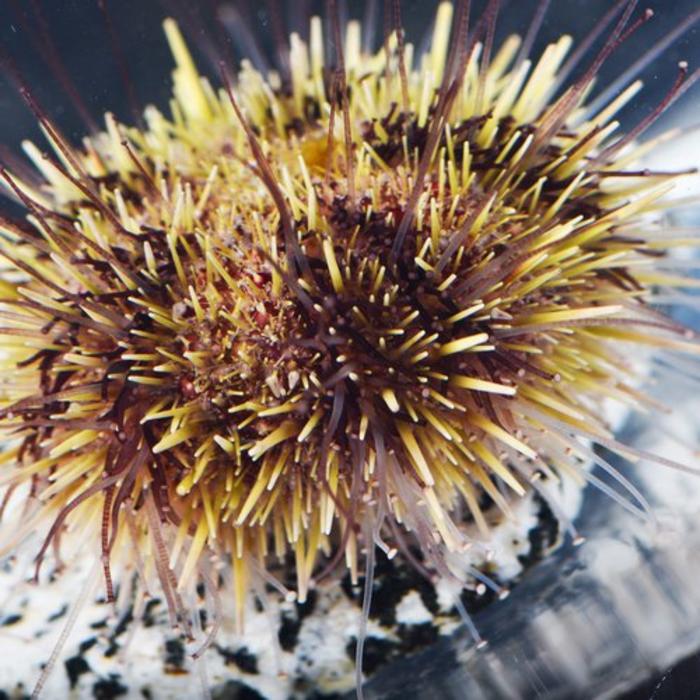When driving through a rainstorm, traction is key. If your tires lack sufficient tread, your vehicle will slip and slide and you won’t have the grip needed to maneuver safely. When torrential rains hit nearshore, shallow water ecosystems, sea urchins experience a similar challenge. Heavy precipitation can alter the concentration of salt in the ocean waters causing lower salinity levels. Even a slight change in salinity can affect the ability of sea urchins to securely attach their tube feet to their surroundings – like tires gripping the road. This becomes a matter of life and death for the small spiny creatures, as they rely on their adhesive structures to move in the wave-battered rocky area near the seashore.

Credit: Syracuse University
When driving through a rainstorm, traction is key. If your tires lack sufficient tread, your vehicle will slip and slide and you won’t have the grip needed to maneuver safely. When torrential rains hit nearshore, shallow water ecosystems, sea urchins experience a similar challenge. Heavy precipitation can alter the concentration of salt in the ocean waters causing lower salinity levels. Even a slight change in salinity can affect the ability of sea urchins to securely attach their tube feet to their surroundings – like tires gripping the road. This becomes a matter of life and death for the small spiny creatures, as they rely on their adhesive structures to move in the wave-battered rocky area near the seashore.
Syracuse University biologists co-authored a study exploring how sea urchin adhesive abilities are affected by differing levels of water salinity.
The survival of sea urchins is vital for maintaining balance within marine ecosystems. Sea urchins are responsible for grazing around 45% of algae on coral reefs. Without sea urchins, coral reefs can become overgrown with macroalgae, which can limit the growth of corals. With the importance of coral reefs for coastal protection and preservation of biodiversity, it is critical to safeguard the sea urchin population.
As global climate change causes weather extremes ranging from heat waves and droughts to heavy rains and flooding, the large amounts of freshwater pouring into nearshore ecosystems are altering habitats. A team of biologists, led by Austin Garner, assistant professor in the College of Arts and Sciences’ Department of Biology, studied the impacts of low salinity and how it alters sea urchins’ ability to grip and move within their habitat. Garner, who is a member of Syracuse University’s BioInspired Institute, studies how animals attach to surfaces in variable environments from the perspective of both the life and physical sciences.
The team’s study, recently published in the Journal of Experimental Biology, sought to understand how sea urchin populations will be affected by future extreme climatic events.
“While many marine animals can regulate the amount of water and salts in their bodies, sea urchins are not as effective at this,” says Garner. “As a result, they tend to be restricted to a narrow range of salinity levels. Torrential precipitation can cause massive amounts of freshwater to be dumped into the ocean along the coastline causing rapid reductions in the concentration of salt in seawater.”
The group’s research was conducted at the University of Washington’s Friday Harbor Laboratories (FHL). The study’s lead author, Andrew Moura, who is a graduate student in Garner’s lab at Syracuse, traveled to FHL along with Garner and researchers from Villanova University to conduct experiments with live green sea urchins. They worked alongside former FHL postdoctoral scholar Carla Narvaez, who is now an assistant professor of biology at Rhode Island College, and Villanova University professors Alyssa Stark and Michael Russell.
At FHL, the researchers separated sea urchins into 10 groups based on differing salinity levels within each tank, from normal to very low salt content. Among each group, they tested metrics including righting response (the ability for sea urchins to flip themselves over), locomotion (speed from one point to another) and adhesion (force at which their tube feet detach from a surface). In Garner’s lab at Syracuse, he and Moura completed data analysis to compare each metric.
The team found that sea urchin righting response, movement, and adhesive ability were all negatively impacted by low salinity conditions. Interestingly, though, sea urchin adhesive ability was not severely impacted until very low salinity levels, indicating that sea urchins may be able to remain attached in challenging nearshore environmental conditions even though activities that require greater coordination of tube feet (righting and movement) may not be possible.
“When we see this decrease in performance under very low salinity, we might start seeing shifts in where sea urchins might be living as a consequence of their inability to remain stuck in certain areas that experience low salinity,” explains Moura. “That could change how much sea urchin grazing is happening and could have profound ecosystem effects.”
Their work provides critical data that enhances researchers’ ability to predict how important animals like sea urchins will fare in a changing world. The adhesion principles Garner and his team are exploring could also come in handy for human-designed adhesive materials – work that aligns with the Syracuse University BioInspired Institute’s mission of addressing global challenges through innovative research.
“If we can learn the fundamental principles and molecular mechanisms that allow sea urchins to secrete a permanent adhesive and use it for temporary attachment, we could harness that power into the design challenges or our adhesives today,” says Garner. “Imagine being able to have an adhesive that is otherwise permanent, but then you add another component, and it breaks it down and you can go stick it again somewhere else. It’s a perfect example of how biology can be used to enhance the everyday products around us.”
Journal
Journal of Experimental Biology
DOI
10.1242/jeb.245750
Article Title
Hyposalinity reduces coordination and adhesion of sea urchin tube feet
Article Publication Date
30-Jun-2023




